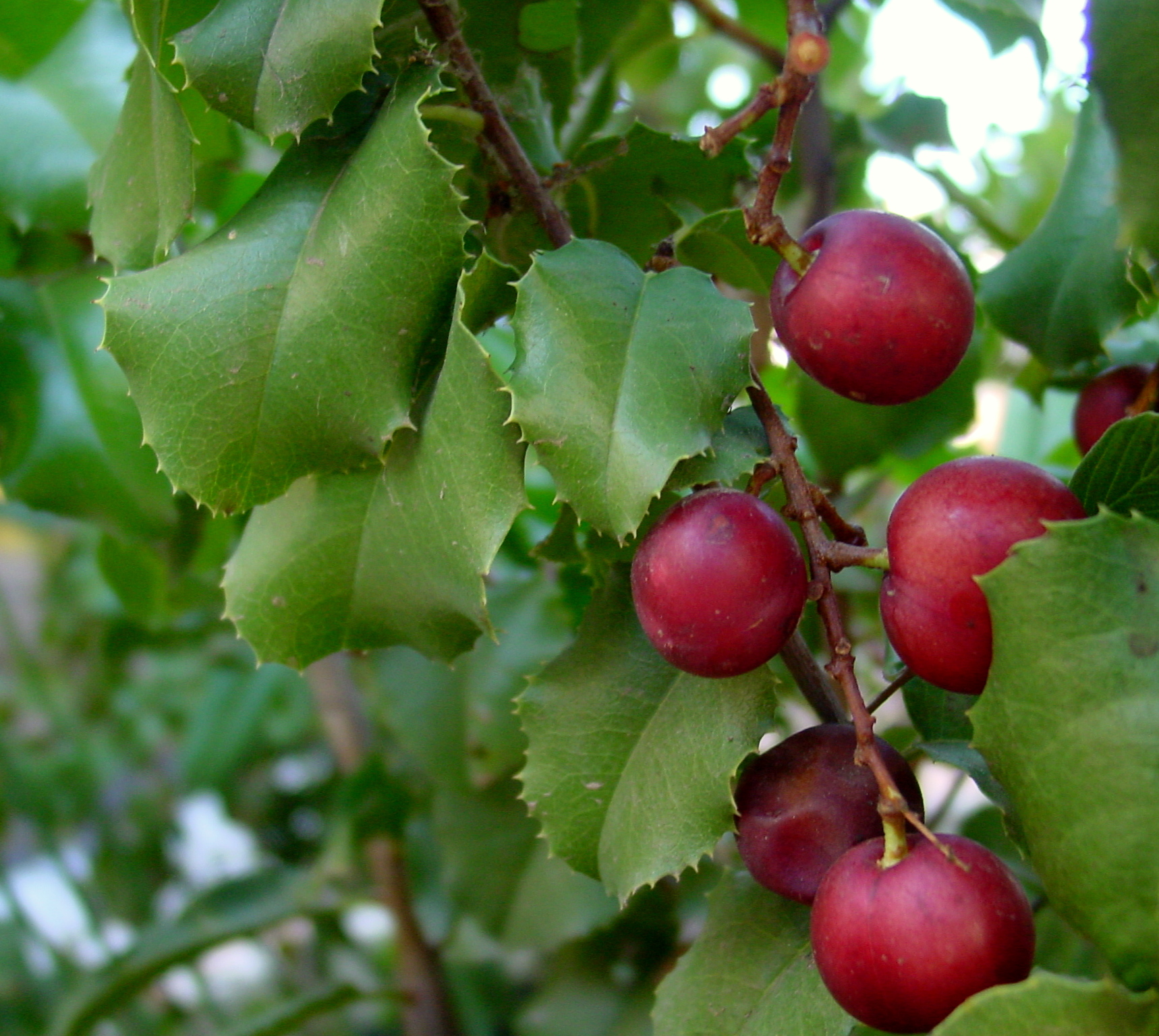- Prunus ilicifolia
Taxobox
name = "Prunus ilicifolia"

image_width = 240px
regnum =Plantae
divisio = Magnoliophyta
classis =Magnoliopsida
ordo =Rosales
familia =Rosaceae
subfamilia =Prunoideae
genus = "Prunus "
species = "P. ilicifolia"
binomial = "Prunus ilicifolia"
binomial_authority = (Nutt. ex Hook. & Arn.) Walp."Prunus ilicifolia" (Hollyleaf Cherry or Evergreen Cherry;
Salinan Native American: Islay [Gudde, E. G. (1946). The Solution of the Islay Problem. "California Folklore Quarterly" 5 (3): 298-299 (Gudde concludes that the word "islay" originated in a Salinan word "slay"; Islay was the Spanish version of their word).] ) is a species in the genus "Prunus ", native to coastalCalifornia and northernBaja California .Germplasm Resources Information Network: [http://www.ars-grin.gov/cgi-bin/npgs/html/taxon.pl?30006 "Prunus ilicifolia"] ] Fire Effects Information Service, USDA Forest Service: [http://www.fs.fed.us/database/feis/plants/shrub/pruili/introductory.html "Prunus ilicifolia"] ]It is an
evergreen shrub or smalltree up to 15 m tall, with dense,sclerophyllous foliage. The leaves are 1.6-12 cm long with a 4–25 mm petiole and spiny margins, somewhat resembling those of theholly , hence its English name; they are dark green when mature and generally shiny on top, and have a smell resemblingalmond s when crushed. Theflower s are small (1-5 mm), white, produced onraceme s in the spring. Thefruit is acherry 12–25 mm diameter, edible and sweet, but contains little flesh surrounding the smooth seed.Jepson Flora: [http://ucjeps.berkeley.edu/cgi-bin/get_JM_treatment.pl?Prunus+ilicifolia "Prunus ilicifolia"] ] Munz, Philip A. 1973. A California flora and supplement. Berkeley, CA:University of California Press.] [Conrad, C. E. (1987). Common shrubs of chaparral and associated ecosystems of southern California. Gen. Tech. Rep. PSW-99. Berkeley, CA: U.S. Department of Agriculture, Forest Service, Pacific Southwest Forest and Range Experiment Station.]There are two
subspecies :Jepson Flora: [http://ucjeps.berkeley.edu/cgi-bin/get_JM_treatment.pl?6677,6866,6875,6876 "Prunus ilicifolia" subsp. "ilicifolia"] ] Jepson Flora: [http://ucjeps.berkeley.edu/cgi-bin/get_JM_treatment.pl?6677,6866,6875,6877 "Prunus ilicifolia" subsp. "lyonii"] ] Schoenherr, A. A. (1993). "A Natural History of California". University of California Press, Berkley.]
*"Prunus ilicifolia" subsp. "ilicifolia". Mainland California and Baja California. Fruit red, 12–18 mm diameter.
*"Prunus ilicifolia" subsp. "lyonii" (Eastw.) Raven. Catalina Cherry.Channel Islands of California (San Clemente, Santa Catalina, Santa Cruz andSanta Rosa Island islands). Fruit blue-black, 15–25 mm diameter.Habitat and ecology
"Prunus ilicifolia" is native to California
chaparral and foothill woodlands along theCoast Ranges below 1,600 m Its distribution extends from northernBaja California along theCalifornia coast to the northernmost extent of theCoast Ranges . In chaparral communities, it tends to inhabit north-facing slopes, erosion channels, or other moist, cool, sites.It is a persistent member of chaparral communities, being slow-growing but long-lived. In the absence of fire, "P. ilicifolia" will outlive or outshade surrounding vegetation, making room for seedlings. Eventually, it will form extensive stands co-dominated by scrub oak. Although it will stump-sprout after fires, the seeds are not fire-adapted like those of many other chaparral plants are.Keeley, Jon E. 1987. Role of fire in seed germination of woody taxa in California chaparral. "Ecology" 68(2): 434-443; cited in [http://www.fs.fed.us/database/feis/plants/shrub/pruili/botanical_and_ecological_characteristics.html FEIS] ] Instead, it relies on the natural death of surrounding vegetation during long periods of fire-free conditions to make room for its seedlings.
The seeds will only germinate after an acid treatment, such as that received when they pass through the digestive tract of
coyote s orbird s which feeds on the fruits. The coyotes are discouraged from eating the seeds themselves by cyanide, which is released from the seeds if they are cracked. Others report that germination levels are high with only suitable moisture and temperature levels. [Mirov, N. T., & Kraebel, C. J. (1937). Collecting and propagating the seeds of California wild plants. "Research Note" 18: 1-27. Berkeley, CA: U.S. Department of Agriculture, Forest Service, California Forest and Range Experiment Station.] Sufficient light levels are also reported to be necessary for germination.The caterpillars of the pale swallowtail ("
Papilio eurymedon") feed on this and other members of the riparian woodland plant community.References
Wikimedia Foundation. 2010.
